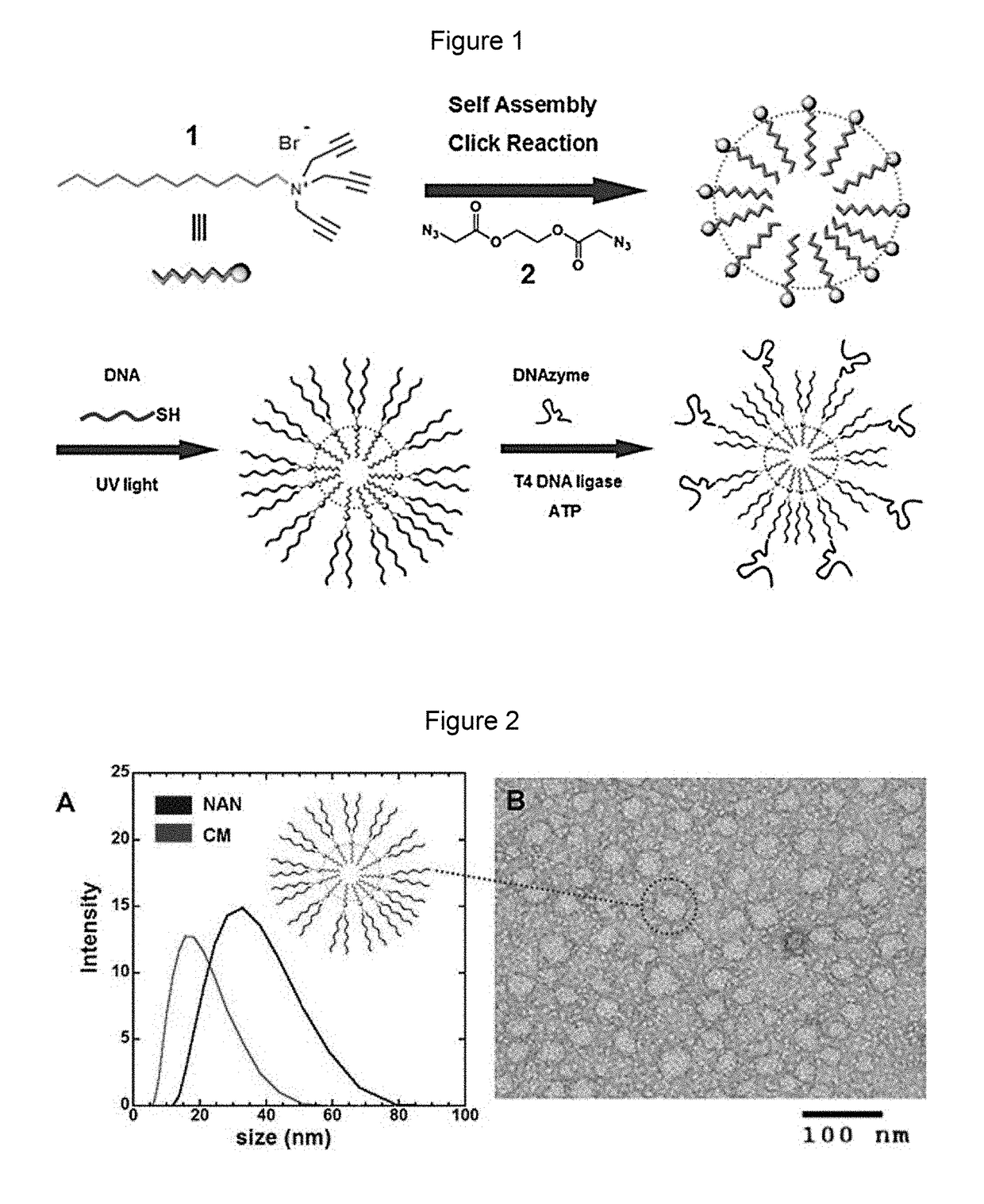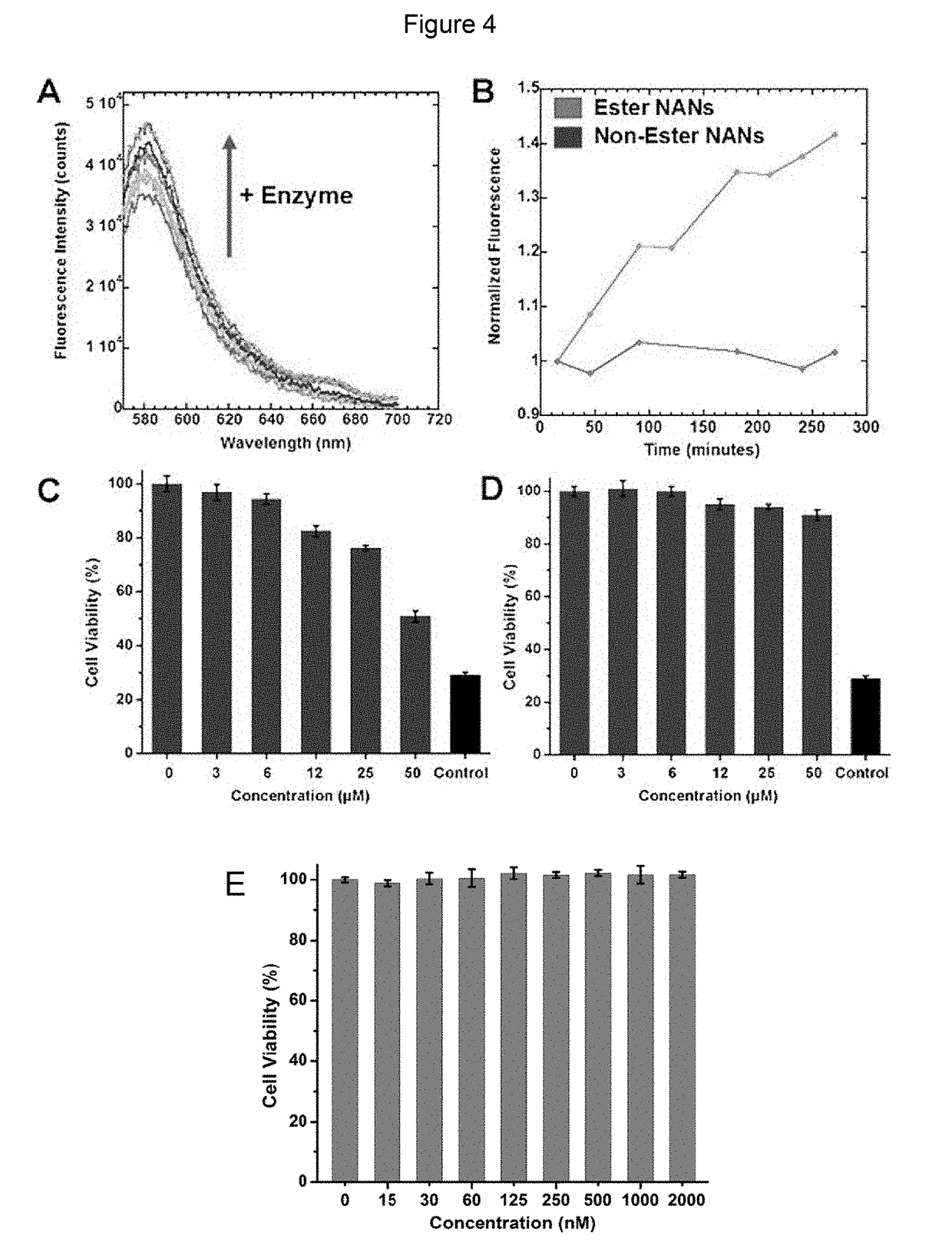Nucleic acid nanocapsules for drug delivery and targeted gene knockdown
a technology of nucleic acid nanocapsules and gene knockdown, which is applied in the field of multifunctional nanoparticles, can solve the problems of affecting the overall efficacy of molecules and the inability of particle cores to contribute to the overall therapeutic function,
- Summary
- Abstract
- Description
- Claims
- Application Information
AI Technical Summary
Benefits of technology
Problems solved by technology
Method used
Image
Examples
example 1
on and Evaluation of Ester-Crosslinked NANs
[0077]General method: For the purposes of synthesis and spectroscopic analyses, methylene chloride, methanol, hexanes, tetrahydrofuran, dimethylformamide, acetonitrile, and ethyl acetate were of HPLC grade. All other reagents and solvents were of ACS-certified grade or higher, and were used as received from commercial suppliers. 1H and 13C NMR spectra were recorded on a Bruker DRX-300 spectrometer. Mass spectrometry analysis was recorded on a Sciex QSTAR Elite mass spectrometer.
Synthesis of Surfactant 1 (N,N,N-tri(prop-2-yn-1-yl)dodecan-1-aminium bromide)
[0078]
[0079]To a solution of dodecylamine (50 mg, 0.27 mmol) in 10 mL of methanol, anhydrous potassium bicarbonate (90 mg, 0.64 mmol) was added followed by dropwise addition of propargyl bromide (67 mg, 0.57 mmol) for a period of one minute. The mixture was stirred at room temperature for 12 hours after which propargyl bromide (34 mg, 0.29 mmol) was added and the solution stirred further at...
example 2
on of Drug-Loaded Ester-Crosslinked NANs
[0089]Ligation of DNAzyme / mutated DNAzyme to Nucleic Acid Nanoparticle (NAN): 10 μM GATA-3 DNAzyme / mutated DNAzyme and 20 μM GATA-3 DNAzyme bridge / mutated DNAzyme bridge were added to 200 μL of 4 μM solution of NANs of Example 1 functionalized with anchor. Water was added to the sample to reach a total volume of 300 μL. The solution was heated at 70° C. for 10 minutes and cooled to room temperature. 5 mM ATP, 15 μL of 1 U / μL T4 DNA Ligase (Invitrogen), 1× ligase buffer were mixed. Water was added to this second solution to reach a total volume of 300 μL. Placed on 25° C. heat block for 2 hours, ligase was heat inactivated at 65° C. for 10 minutes.
TABLE 1DNAzyme-NAN characterization and activity assaysDNA and RNA sequencesAnchor 5′-SH-TTT TTT TTT TCA CGT(AKH-anchor)CCA GCA G-3′(SEQ ID NO: 1)GATA-3 **DNAzyme5′-GTG GAT GGA GGC TAG CTA CAA CGA GTC TTG GAG-3′(SEQ ID NO: 2)GATA-35′-GCC TCC ATC CAC CTG CTGDNAzymeGAC GTG-3′bridge(SEQ ID NO: 3)Mutate...
example 3
on and Evaluation of Peptide-Crosslinked NANs
[0102]Peptide Surface Crosslinked Micelles (pep-SCMs): A typical procedure is illustrated in FIG. 6. For example, 1.9 mg of surfactant 1 was dissolved in Millipore water (500 μL). 31.25 μL of a 4 mM 5-carboxytetramethylrhodamine (5-TAMRA) stock solution in DMSO was added to the micelle solution and allowed to stir for 30 minutes at room temperature. 17 μL of either CGFLGC (cathepsin B substrate) (SEQ ID NO:8) or CGPLGLAGGERDGC (MMP9 substrate) (SEQ ID NO:9) was added to 232 μL of the micelle solution. 1 μL of 2-hydroxy-4-(2-hydroxyethoxy)-2-methylpropiophenone (DHEMPP) was also added, resulting in the following final concentrations: surfactant (9.28 mM), 5-TAMRA (250 μL), peptide crosslinker (5 mM) and DHEMPP (20 μM). The final solution was placed in a Rhyonet reactor for 30 minutes. The product was characterized by DLS and zeta potential on a Zetasizer Nano-ZS90, by TEM, and by 1% agarose gel electrophoresis.
[0103]Peptide Nucleic Acid Na...
PUM
| Property | Measurement | Unit |
|---|---|---|
| Therapeutic | aaaaa | aaaaa |
| Hydrophilicity | aaaaa | aaaaa |
| Hydrophobicity | aaaaa | aaaaa |
Abstract
Description
Claims
Application Information
 Login to View More
Login to View More - R&D
- Intellectual Property
- Life Sciences
- Materials
- Tech Scout
- Unparalleled Data Quality
- Higher Quality Content
- 60% Fewer Hallucinations
Browse by: Latest US Patents, China's latest patents, Technical Efficacy Thesaurus, Application Domain, Technology Topic, Popular Technical Reports.
© 2025 PatSnap. All rights reserved.Legal|Privacy policy|Modern Slavery Act Transparency Statement|Sitemap|About US| Contact US: help@patsnap.com



